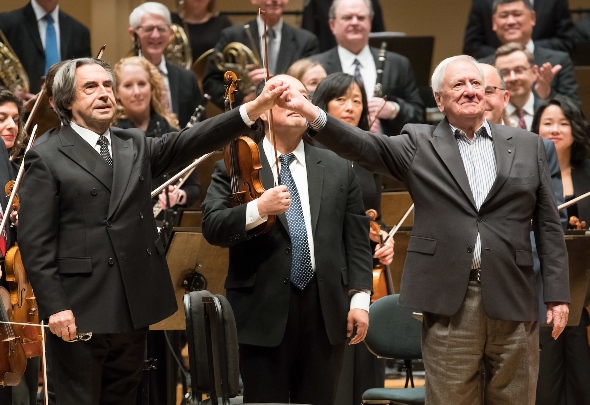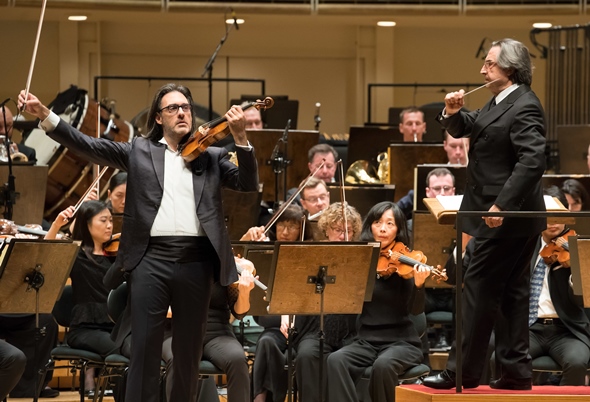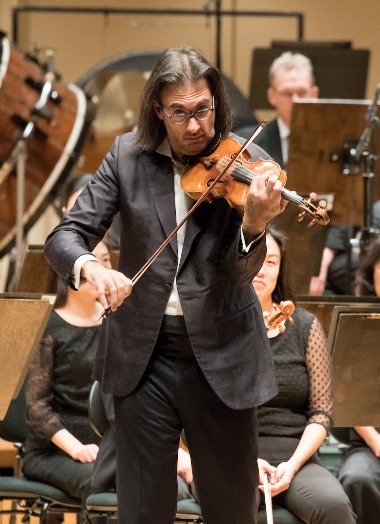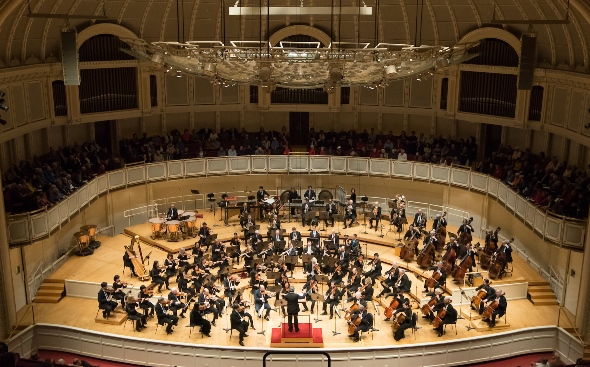Muti, CSO deliver turmoil of Rands’ ‘Dream,’ and a Beethoven Violin Concerto for the ages

CSO music director Riccardo Muti, left, and composer Bernard Rands shared the ovation after the world premiere of Rands’ “Dream” at Orchestra Hall. (Anne Ryan photos)
Review: Chicago Symphony Orchestra conducted by Riccardo Muti; Leonidas Kavakos, violin. Repeats at 7:30 p.m. Tuesday.
By Lawrence B. Johnson
It was a dream musical encounter of parts Nov. 1 at Orchestra Hall: the Chicago Symphony Orchestra with music director Riccardo Muti offering the world premiere of Bernard Rands’ “Dream” and a consummate – and certainly novel – performance of Beethoven’s Violin Concerto with the Greek wizard Leonidas Kavakos.
The Chicagoan Rands and the Italian Muti share a long history together going back to the conductor’s time in the 1980s as music director of the Philadelphia Orchestra. Muti has presided over a number of Rands’ compositions, and to say the two musicians are simpatico is surely an understatement. That was clear enough in Muti’s probing account of Rands’ complex and turbulent “Dream,” which is anything but dreamy.
No “Liebestraum” this; rather Rands’ 15-minute essay evokes something closer to the convulsive, sleep-intruding portraiture of Berlioz’s “Symphonie fantastique,” particularly that work’s closing “Dream of a Witches’ Sabbath.” Indeed, Rands’ fraught, imaginative and vibrantly hued “Dream” might be characterized as a modernist refraction of Berlioz’s fantasy perceived through the prism of Debussy. The work of a worldly 21st-century American, Rands’ bracing mindscape nonetheless struck me as distinctively French.
Mutual understanding was in the air as the CSO sounded the depths of “Dream.” Not only can Rands boast of a long association with Muti, but this orchestra has played his works under Daniel Barenboim and Pierre Boulez as well. That conditioned rapport was instantly evident in the first tumultuous wave of winds and brass that announced something like a nightmare at hand.
If “Dream” is rather conservatively cast harmonically, it is brilliantly and compellingly fashioned in both its orchestral colors and its interleaving of voices in conflict. It is virtuosic writing for orchestra, as incisive as it is surprising and elemental. Rather than harmonic analysis, the more useful approach might be psychoanalysis. Muti and company captured the music’s singular urgency as well as its crashing emotional swings. That collectively stunning effect resonated in boisterous applause for the 85-year-old composer whose eminence this CSO commission honored.
Kavakos’ incandescent performance of the Beethoven Violin Concerto occupied the concert’s first half. It is likely to park in memory for a good long time to come. This was violin playing that connected heart to heart – that of Beethoven’s sublime music to that of the transfixed listener. And to judge from the audience’s roof-lifting response, that would be essentially everyone in the hall.
Beethoven’s Violin Concerto falls amid the treasured works of his so-called middle period. Its immediate companions are the likes of the “Eroica” Symphony and Fourth Piano Concerto, the “Appassionata” Piano Sonata and the three pivotal “Razumovsky” String Quartets of Op. 59. The Fifth and Sixth Symphonies lay just ahead.
While the Violin Concerto approaches the monumental frame and scope of the “Eroica” Symphony, in temperament it lies closer to the introspective, lyrical and serene Fourth Piano Concerto. And that was the core beauty of an exquisite collaboration between Kavakos and Muti. The effect was quietly tremendous, Kavakos’ prodigious virtuosity and silvery sound compounded by orchestral playing of Classical precision, buoyancy and restraint.

The end! Violinist Leonidas Kavakos and conductor Riccardo Muti hit the finish line together in the Beethoven Violin Concerto.
The slow movement was a thing of breathtaking magnificence, the silken solo voice often descending to the very threshold of audibility though its intensity never waned. Muti and company somehow managed to sustain support that didn’t cover that gentle filament.
But violinist and orchestra also could generate power where it was called for – and humor. Beethoven’s broadly drawn rondo finale was a delight. There were surprises, too: all of the solo violin cadenzas.
Beethoven recast the Violin Concerto as a piano concerto, and in doing so created several dazzling keyboard cadenzas – which Kavakos translated back to the violin. The results are several flights of fancy that one might more readily take for Paganini than Beethoven. The huge first-movement cadenza is a wild affair that ends up as a violin rhapsody with timpani obbligato! One couldn’t help wondering if this was the first time the CSO’s adroit principal timpani, David Herbert, had ever accompanied a cadenza.
Muti’s bountiful program was capped off by more riches still: Liszt’s dramatic symphonic poem “Mazeppa,” which summons a legendary warrior and lover whose illicit affair cost him dearly. He is stripped and tied to a horse that gallops through forest and field. Mazeppa survives to become a hero and military leader. Liszt depicted the tale as an unbroken series of musical tableaux, splendorous and impassioned and virtuosic. Which exactly describes the blazing account the Chicago Symphony conjured under Muti’s artful leadership.
Related Link:
- Performance and ticket info: Details at CSO.org



